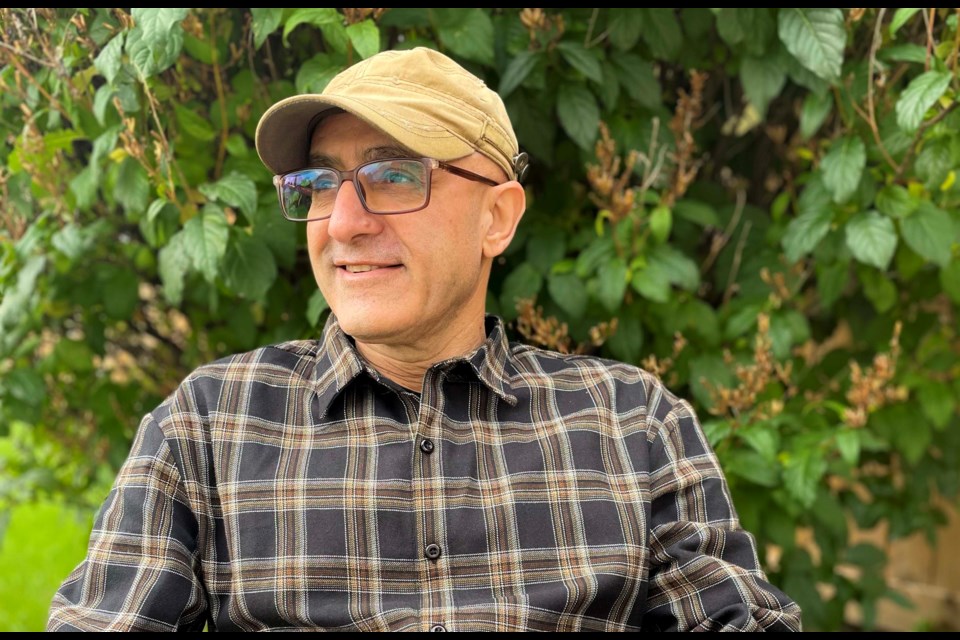The Art Gallery of St. Albert’s newest main gallery exhibition is quite possibly one of the most fragile and gentle hosted in the city. It is also one of the most socially engaging and politically charged, reflecting a massive upheaval in the world today.
Edmonton based Riaz Mehmood captures the complex history of his home province Khyber Pakhtunkhwa, Pakistan, a northern area that has witnessed a vacillating control between the all-powerful Pakistani army and Taliban terrorists.
His latest exhibition titled Remember – Resist – Relive centres around a horrific school shooting that occurred in Peshawar, a 2,000-year-old city dubbed The City of Flowers. Known for its bounty of flowers and greenery, the entire city was changed on Dec.16, 2014 after seven heavily armed Taliban fighters stormed an army-run school killing 150 people, of whom at least 134 were students.
At the time, the army-run school enrolled primary and secondary school students, many of whom were children of military personnel. On the day of the attack, the terrorists bombed their vehicle to create a distraction, scaled a wall, entered the school and began to indiscriminately shoot anyone in sight. They carried grenades and automatic rifles and were under orders only to kill. There was no attempt to take hostages.
Commandos from the Special Services Group of the Pakistani army arrived, but it took eight hours before they were able to control the situation. The Pakistani branch of the Taliban, Tehrik-e-Taliban (TTP), a militant Islamic movement, took credit for the attack.
“The Pakistan army killed some of their leaders and it was revenge,” said Mehmood. “I read about it, and I was extremely worried. I was so worried at first, I couldn’t call my relatives. I wasn’t prepared for the news.” Fortunately, no members of his immediate family were injured.
However, the 14-year-old son of a distant cousin was shot. Another acquaintance, the son of a cousin’s friend was shot in the head and face but survived. Even though the young man received extensive rehabilitation, he still deals with injuries nearly a decade later.
The attack was condemned by the public, government officials, political and religious groups, journalists and members of all levels of Pakistani society. When mothers heard the government and army had intelligence of an imminent attack and did nothing to prevent it, they demanded answers.
“There are still no answers and court cases are going on,” Mehmood said. “The state wants them to move on and claim the death of their children as part of a sacrifice for the nation. But the parents and larger community are not letting this go.”
The attack was a flashpoint moment for parents and demonstrators who continue to demand answers and hold on to the memories of the children — not as martyrs of the state, but as innocents who had no part in terrorism’s horror machine.
“For me, this Remember – Resist – Relive is a form of resistance. The government wants to erase the whole story. This is a hopeful sign of active resistance and active resistance is a form of memory.”
The exhibition is composed of a 117-inch-high paper scroll designed with bleeding red flowers, delicate floral-paintings and a video presentation. Also hanging on a wall is an elaborate Pakistani tapestry revealing a tangled labyrinth of political gamesmanship executed by the CIA, Taliban, Osama bin Laden’s ISIS, Saudi Arabia and numerous other parties from the time of the Soviet-Afghan Wars in 1979.
“The tapestry traces just how complicated the politics are in the region and how many different players are involved with different motivations — most of what has nothing to do with people living there,” said Emily Baker, gallery curator.
Centred in the exhibition is a wooden two-person desk commonly used in Pakistan surrounded by rows of natural potted flowers standing in grief for the children. Beside each vase is a photo and self-explanatory story of a child.
“Riaz wanted them to feel like rows in a school. The pots are on the floor so you can get down low and see them closely,” Baker said.
Laying on the desk are books, both in English and Pashto, the major language spoken in Peshawar.
“The idea of the desk is as a presence, a memory of them. They are with us even though they are not here physically,” Mehmood explained.
The complete effect is at once light and subtle, yet complex and disturbing.
He concludes saying, “For visitors I wanted it to be sublime and gentle, not overrun by sadness. There is hope for the future, and that war and destruction does not define Pakistani people.”
He added certain incidents in life become part of a region’s identity and collective way of thinking.
“This has become part of the collective Pashtun psyche. There's been a lot of talk about writing poems and art. These kinds of incidents should never be repeated. They happened, but they should never be repeated.”
Remember – Resist – Relive runs until Sept. 30. A virtual tour on Facebook Live is on Sept. 13 at noon, and an artist talk and reception will be held Sept. 28 from 6 p.m. to 8 p.m.




